How many people do we grant asylum or protection to?
Updated 22 August 2019
Back to ‘Immigration Statistics, year ending June 2019’ content page.
This is not the latest release. View latest release.
Data relate to the year ending June 2019 and all comparisons are with the year ending June 2018, unless indicated otherwise.
This section contains data on:
- Asylum applications and initial decisions, including unaccompanied asylum-seeking children (UASC)
- Resettlement
- Family reunion visas granted
- Asylum support
- Outcome analysis of asylum applications
1. Asylum, resettlement and protection
The UK gave protection – in the form of grants of asylum, humanitarian protection, alternative forms of leave and resettlement – to 18,519 people in the year ending June 2019 (up 29% compared with the previous year). Of these, 40% (or 7,351) were children. This was the highest number of people granted protection in the UK over a one-year period since the year ending September 2003.
The total number of people offered protection in the year ending June 2019 comprised:
- 10,555 grants of asylum (up 61%), with notable increases in grants to Iranian (up 851), Sudanese (up 713), Eritrean (up 617), Afghan (up 504), and Turkish (up 487) nationals.
- 1,126 grants of humanitarian protection (up 31%). Libyan nationals received 683 of these, over half of the total.
- 1,147 grants of alternative forms of leave following an application for asylum (down 3%), including a reduction in numbers obtaining UASC Leave (down 210 or 49%).
- 5,691 people provided protection under resettlement schemes (a similar number to the previous year).
In the year ending June 2019, 44% of initial decisions on asylum applications were grants of asylum, humanitarian protection or alternative forms of leave (such as discretionary leave or UASC leave), compared with 29% in the previous year.
Grant rates vary considerably by nationality. Of those that commonly claim asylum in the UK, nationals from Libya (95% granted), Syria (89%) and Eritrea (74%) have particularly high grant rates at initial decision, while nationals of India (6%), China (8%) and Bangladesh (12%) have very low proportions of applications granted at initial decision.
The grant rate at initial decision also varies by age of applicant. In the year ending June 2019, the grant rate for main applicants aged under 18 was 88%, twice the average, whereas grant rates for those aged 18 to 69 were constant at around 40%.
Additionally, 5,993 Family reunion visas were issued to partners and children of those previously granted asylum or humanitarian protection in the UK, a similar number to the previous year. Of these, around half (2,913) were issued to children.
Figure 1: Grants1 of asylum, alternative forms of leave2, and resettlement3,4
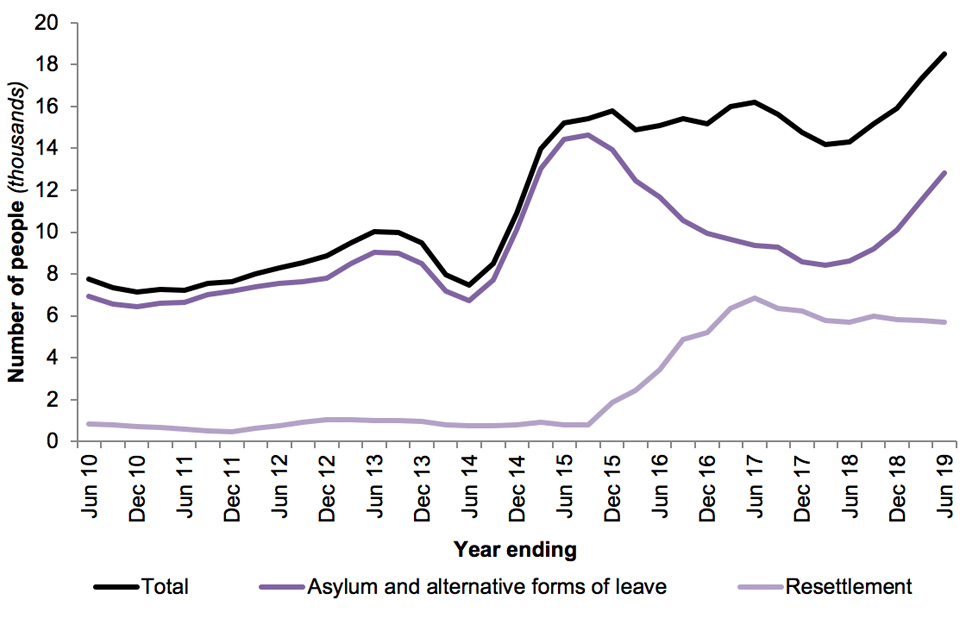
The chart shows the number of people granted asylum and other forms of protection and resettlement (main applicants and dependants) over the last 10 years.
Source:
Asylum tables – Initial decisions and resettlement
Chart notes:
- Grants at initial decision. Actual number of grants at final decision (following appeal) will be higher.
- ‘Alternative forms of leave’ include grants of humanitarian protection, discretionary leave, grants under family and private life rules, leave outside the rules, Calais Leave and UASC leave, that resulted from an asylum application.
- Resettlement data prior to 2013 are only available annually. Data for individual quarters in this period have been estimated by taking 25% of the annual total.
- Includes main applicants and dependants.
1.1 Resettlement
The Vulnerable Person Resettlement Scheme (VPRS) accounted for nearly three-quarters (4,200) of those resettled in the UK in the year ending June 2019. Since it began in 2014, 17,051 people have been resettled under the scheme.
A further 742 were resettled under the Vulnerable Children Resettlement Scheme (VCRS) over the last year.
Of those resettled under the VPRS and VCRS in the year ending June 2019, 202 refugees were resettled in the UK through the Community Sponsorship scheme. Since this scheme began in July 2016, 344 refugees have been resettled by community sponsor groups. Details of the scheme can be found in the ‘About the statistics’ section.
1.2 Asylum applications
There were 32,693 asylum applications in the UK (main applicants only) in the year ending June 2019, 21% more than the previous year but below the level seen in the year ending June 2016 during the European migration crisis.
Over the same period, there were 3,496 applications from UASCs, 39% more than the previous year; UASCs accounted for 11% of total asylum applications in the latest year.
Figure 2: Asylum applications lodged in the UK1
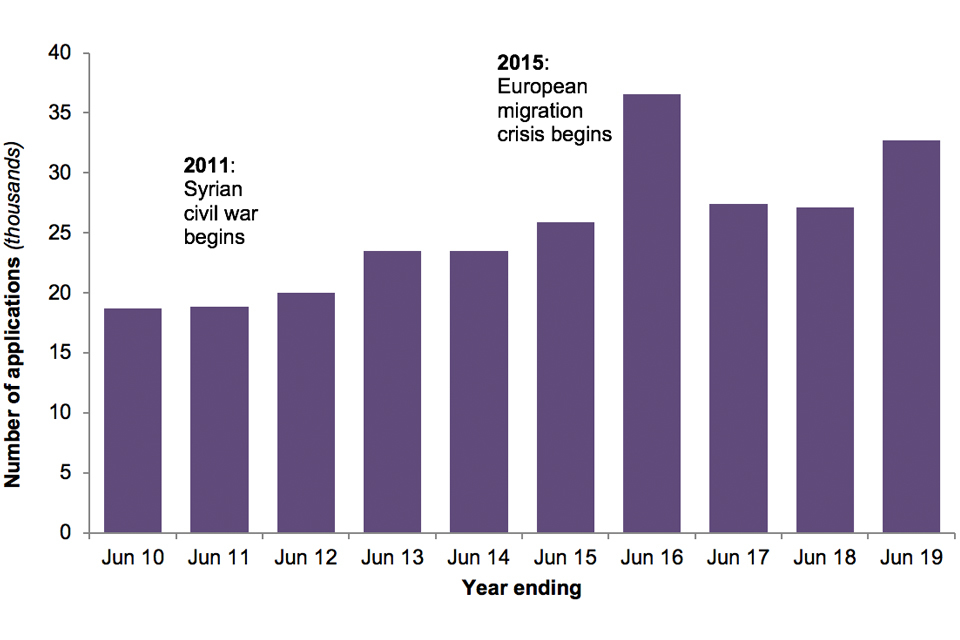
The chart shows the number of asylum applications made in the UK (main applicants only) over the last 10 years.
Source:
Asylum tables – Asylum applications
Chart note:
- Includes main applicants only.
The latest Asylum statistics produced by Eurostat show the number of asylum applications to EU member states decreased by 3% in the year ending March 2019, although this was driven by falls in applications to Italy and Germany. Spain, France, Greece, Netherlands and Belgium all saw increases. The UK received the 6th highest number of applications of all EU member states in the year ending March 2019.
Table 1: Top 10 nationalities applying for asylum in the year ending June 2019
| Nationality | Number of applications | Change (latest year) | % Change2 | Grant rate3 |
|---|---|---|---|---|
| Iran | 4,208 | +1,776 | +73% | 62% |
| Iraq | 3,180 | +771 | +32% | 26% |
| Albania | 2,801 | +1,263 | +82% | 15% |
| Eritrea | 2,239 | +714 | +47% | 74% |
| Pakistan | 1,872 | -445 | -19% | 28% |
| Sudan | 1,689 | +49 | +3% | 71% |
| India | 1,408 | +202 | +17% | 8% |
| Vietnam | 1,346 | +274 | +26% | 45% |
| Afghanistan | 1,341 | -41 | -3% | 61% |
| Bangladesh | 1,249 | -256 | -17% | 13% |
Sources:
Asylum tables – Asylum applications
Asylum tables – Initial decisions and resettlement
Chart notes:
- Includes main applicants only.
- Change compared with the previous year.
- Grant rate is the proportion of initial decisions which resulted in a grant of protection or other leave. Grant rate is based on year of initial decision, and is not directly comparable to applications, which are based on the date the asylum application was made.
Iranian nationals accounted for the largest increase of all nationalities applying for asylum. This reflects a return to similar levels to the year ending June 2016, following falls in the last two years. Albanian nationals saw the second highest increase, following five consecutive years of approximately constant numbers of applications.
The demographics of those applying for asylum varies by nationality. Around three-quarters (74%) of all asylum applicants in the latest year were male. However, of the top 10 nationalities applying, Bangladeshi, Sudanese, and Afghan nationals all saw a higher percentage of applications from males (91%, 89% and 87% respectively), whereas Vietnamese and Albanian nationals had a below average proportion of applications from males (64% and 67% respectively).
The largest numbers of asylum applications from UASCs in the year ending June 2019 came from Eritrean (766), Sudanese (508) and Iraqi (457) nationals. UASCs accounted for 34% of all Eritrean asylum applications over the period, and a similar proportion (30%) of Sudanese asylum applications, while for Iraqis only 14% of applications were from UASCs – slightly above the average of 11% across all nationalities. A large proportion (26%) of Vietnamese asylum applications were from UASCs.
Of the 32,693 asylum applications, 44% of main applicants were aged 18 to 29, and a further 11% were children, meaning that around 45% were aged 30 years or over. The age of asylum applicants varied by nationality. For example, 34% of Eritrean and 30% of Sudanese main applicants were children (under the age of 18), compared to less than 1% of Indian and Bangladeshi main applicants.
Figure 3: People applying for asylum in the year ending June 20191 by age group2 and sex
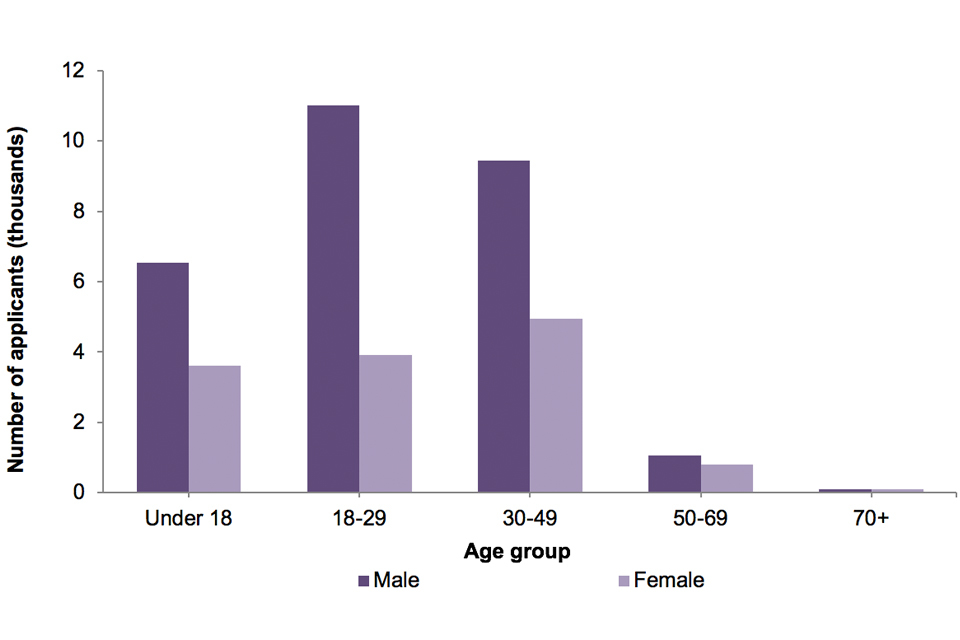
The chart shows the number of asylum applications made in each age group, broken down by sex, in the year ending June 2019.
Source:
Asylum tables – Asylum applications
Chart notes:
- Includes main applicants and dependants.
- Age relates to age at time of application.
2. Support provided to asylum seekers
At the end of June 2019, 45,203 asylum seekers in the UK were in receipt of support under Section 95 of the Immigration and Asylum Act 1999, up 6% from the same time the previous year.
Of these, 42,182 (93%) were in receipt of either accommodation only or both accommodation and subsistence, and 3,021 (7%) were in receipt of subsistence only. The majority (83%) were located in England, with smaller supported populations in Scotland (9%), Wales (6%) and Northern Ireland (2%).
As at the end of June 2019, 4,019 (6.4 per thousand population) asylum seekers with an address registered in Glasgow were in receipt of Section 95 support, the highest of all local authorities. There were a further 17 local authorities in which more than three asylum seekers per thousand population were provided support under Section 95.
Figure 4: Asylum seekers supported under Section 951,2, by local authority3, as at end of June 2019
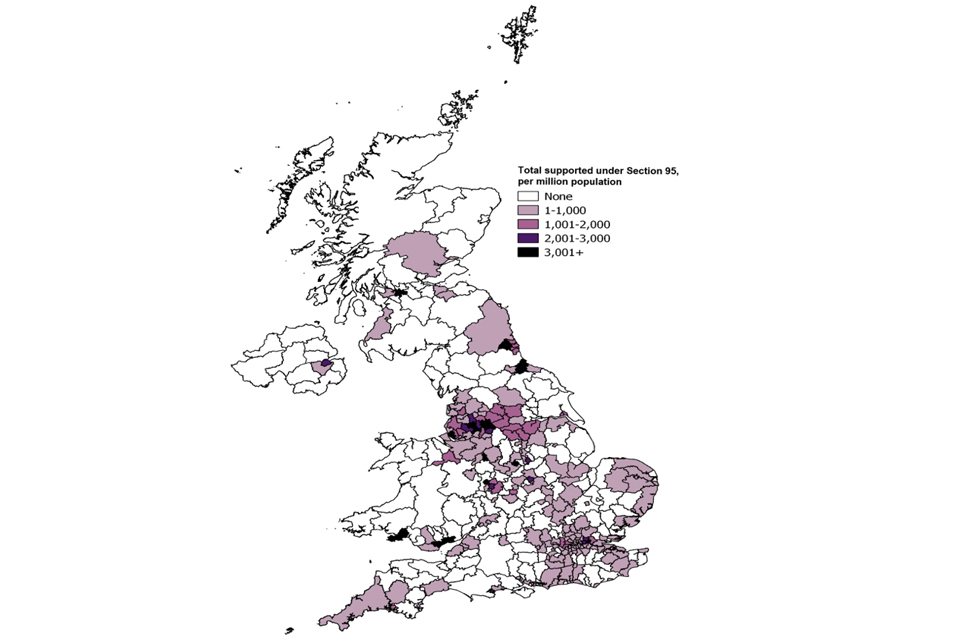
The chart shows the number of people per million of the population in receipt of Section 95 support, by local authority, as at the end of June 2019.
Source:
Asylum tables – Section 95 support by local authority)
Chart notes:
- Includes main applicants and dependants.
- Local authority data are based on the registered address of the asylum seeker. This is not necessarily the location at which the individual regularly resides.
An additional 3,893 individuals were in receipt of support under Section 4 of the Immigration and Asylum Act 1999, down 7% from the previous year, and 1,583 individuals were in receipt of support under Section 98 of the Act, 9% fewer than the year before.
3. Outcome of asylum applications
The chart below gives an illustration of the outcomes of asylum applications made in the years 2015 to 2017, where the outcome is known. After the conclusion of any appeals, around half (49%) of all asylum applications in the UK result in some form of grant of leave to remain in the UK.
Of those applications received between 2015 and 2017, 35% were granted at initial decision. The proportion of initial decisions (excluding those that were granted asylum) which were subsequently appealed was 71%, and after further consideration by HM Courts and Tribunals Service (HMCTS), 40% of appeals were allowed. The grant rate increased from 35% at initial decision, to 53% following appeal.
Figure 5: Outcomes of asylum applications with known outcomes, 2015 to 20171,2,3,4

The chart shows the outcome of all asylum applications made between 2015 and 2017, where the case is closed and the outcome is known.
Source:
Asylum tables – Outcome analysis of asylum applications
Chart notes:
- Appeals lodged are presented as a proportion of all initial decisions (except grants of asylum).
- Data include all asylum applications where the application raised date was between 2015 and 2017.
- Cases where initial decision is unknown are not included in this analysis.
- Grant rates shown here relate to the outcomes of total applications made in each cohort year excluding withdrawals.
3.1 Latest outcomes for applications made in 2018
Out of those who applied for asylum in the UK in 2018,15,451 cases are currently awaiting an outcome. As more initial decisions are made, and more appeals completed, the number of grants and refusals for all years (but particularly more recent years) will increase, and this will be reflected in future publications.
Figure 6: Final outcome of asylum applications, by type of outcome1,2
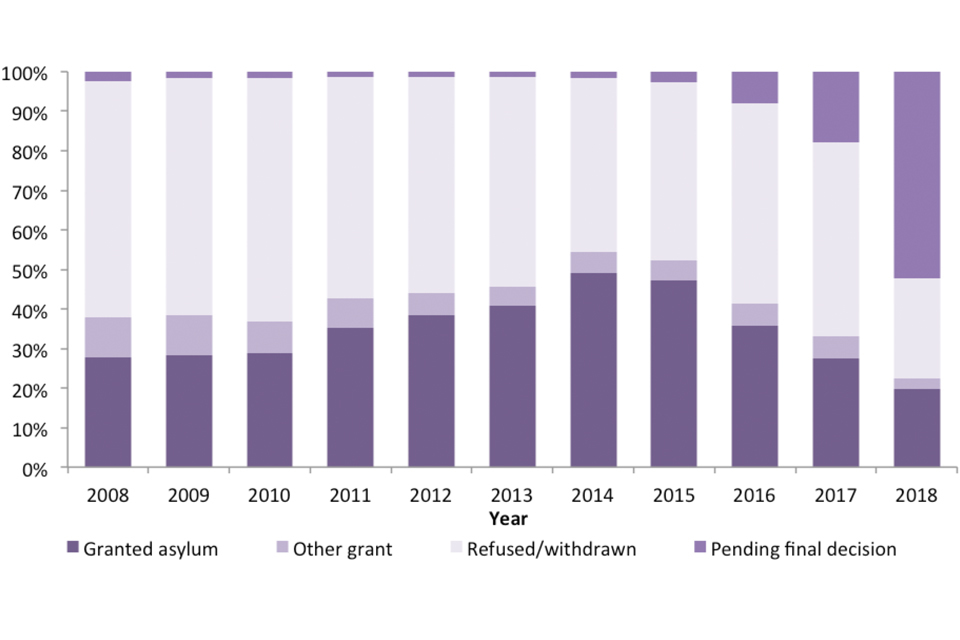
The chart shows the latest outcome of asylum applications made between 2008 and 2018, as at May 2019.
Source:
Asylum tables – Outcome analysis of asylum applications
Chart notes:
- Data are based on date of application, and the outcomes are as at the point of data extraction in May 2019.
- The proportion of applications awaiting an outcome (either an initial decision or an appeal) will be lower in earlier years as more time has elapsed for the cases to be processed than those from more recent years.
The overall proportion of applications granted asylum or an alternative form of protection, either at initial decision or after appeal, was estimated to be 27% in 2004; this proportion has steadily increased to 59% of applications made in 2015 (where the outcome is known). The proportion of applications awaiting an outcome (either an initial decision or an appeal) increases for more recent years as less time has elapsed for the cases to be completed.
4. About the statistics
This section provides information on those applying for and granted protection in the UK through both asylum and resettlement routes, as well as information on the numbers in receipt of asylum support.
The data are used to assess the trends in numbers of people seeking and being granted protection, the impact of policy changes, and to understand the demographics of those coming to the UK to claim protection. Data on resettlement and support, broken down by local authority, can help local authorities understand the demands on their services and resources to aid with planning.
4.1 Asylum, resettlement and protection
The total number of individuals granted protection includes grants related to an asylum application (grants of asylum or alternative protection) and resettlement. Alternative forms of protection include humanitarian protection, discretionary leave, UASC leave, leave outside the rules, Calais Leave, and grants under family and private life rules. Further details can be found in the user guide.
Data on asylum applications relate to the period in which the application was lodged, and initial decisions relate to the period in which the decision was made. Initial decisions may, therefore, relate to an application made in an earlier period, and thus the two are not directly comparable.
Data on initial decisions will not reflect the total number of people granted protection through asylum routes as some initial decisions may be overturned following appeal. Data on the number of appeals lodged are published in Asylum tables – Appeals lodged, and their outcomes in Asylum tables – Appeals determined.
UASC data includes those treated as an unaccompanied minor for at least one day between the date of application and the date of initial decision. Some UASC applicants may subsequently be found to be an adult following conclusion of an age dispute. Data on age disputes are published in Asylum tables – Age disputes.
Figures on international asylum applications are based on data supplied by the individual countries to the Intergovernmental Consultations on Migration, Asylum and Refugees (IGC), United Nations High Commissioner for Refugees (UNHCR) and Eurostat. These may include some estimated figures. Eurostat also publishes a range of asylum statistics which can be used for comparisons across the EU. The methodology used to compile Eurostat data differs from that used in this release. Further details can be found in the user guide.
The UK Community Sponsorship scheme was launched on 19 July 2016. The scheme allows community groups to support refugee families directly and aims to help them become self-sufficient and integrated members of the community. These figures are a subset of those published under the VPRS and VCRS and are not in addition to those resettled under these schemes. Further details can be found on the GOV.UK page.
Family reunion visas are a subset of the ‘Family: other’ visa category, published in the visa tables, of which around 99% relate to Family reunion visas. Data on Family reunion visas come from a different administrative system to other visa data so are not directly comparable. Further details can be found in the user guide.
4.2 Support provided to asylum seekers
Section 95 support is provided to destitute asylum seekers until their claim is finally determined, which may encompass either accommodation or subsistence, or both. ‘Invalid applications for support and support type not yet known’ are cases that have been deemed invalid or which have not yet been assessed.
Section 4 provides support for individuals whose claim has been refused and who have exhausted their appeal rights, but who are destitute and are temporarily unable to leave the UK.
Section 98 support provides accommodation for asylum seekers who would otherwise be destitute and who are either awaiting a decision on an application for Section 95 support or are supported under Section 95 and are awaiting transfer to their accommodation.
The data show the number of people in receipt of support on a given day, but do not show the length of time for which someone receives support or the amount of support they receive.
4.3 Outcome of asylum applications
The most recent data report on the initial decisions made on asylum applications by the Home Office. However, some decisions will be challenged at the HM Courts and Tribunals Service (HMCTS), an executive agency of the Ministry of Justice, which considers appeals against the asylum decisions made by the Home Office.
The Home Office produces an analysis of applications for whole year cohorts of asylum seekers, in order to calculate the overall success rates following appeal. For older years, this will provide the most complete description of the outcome for asylum seekers. However, for the most recent years, a large number of cases will still be outstanding, as not all cases will have had sufficient time to be completed. The analysis therefore only provides a ‘snapshot’ of the recorded outcomes of the group (or cohort) of asylum applicants in any one year, at a particular time. This dataset is updated, in full, annually and is currently available up to 2018.
5. Data tables
As outlined in previous releases, the Home Office has reviewed the format of the published data tables. For this release, the format of the asylum and resettlement tables have changed. These now include summary tables, accompanied by a number of detailed datasets.
The summary tables include a high-level overview of the main datasets published on asylum and resettlement. The detailed datasets allow users to explore the data in more detail as required. The ‘contents’ page within the summary tables contains an overview of the available datasets (including hyperlinks), while the ‘notes’ page shows how the information in the old tables maps to the information in the new tables.
Data referred to here, and related data, can be found in the following tables:
- Asylum summary tables
- Asylum detailed tables
- Asylum claims on the basis of sexual orientation tables
We welcome your feedback
If you have any comments or suggestions for the development of this report, please provide feedback by emailing MigrationStatsEnquiries@homeoffice.gov.uk. Please include the words ‘PUBLICATION FEEDBACK’ in the subject of your email.
See section 7 of the ‘About this release’ section for more details.
